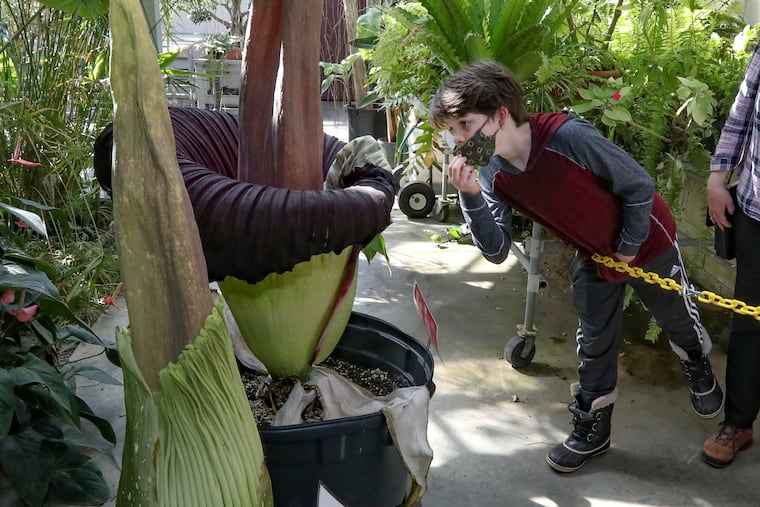Rare ‘corpse flower’ blooms, stinks like rotting flesh at Temple’s Ambler campus
Ben Snyder has made it his mission since graduating from Temple in 2016 to get a rare 'corpse plant' that stinks like a dead body to bloom. He's been successful and we have a time lapse video.

Ben Snyder graduated from Temple University’s Landscape Architecture and Horticulture program in 2016, was hired by the school, and immediately set out on a quixotic quest: Acquire an endangered giant “corpse flower” native to Sumatra, Indonesia, and get it to bloom — a time consuming and difficult task.
Snyder, 26, has been successful. The Amorphophallus titanum began to bloom Sunday at Temple’s Tyler School of Art and Architecture Greenhouse Education and Research Complex in Ambler, which Snyder now manages. The speckled pink and maroon flower was only expected to last 24 to 36 hours before it wilts.
An Amorphophallus in bloom emits a smell likened to that of a dead body, or rotting meat. On Sunday night, the smell was so bad, Snyder said, people were gagging inside the greenhouse and had to leave. They could still smell it outside. The odor was less intense Monday morning.
“When they bloom, it’s truly an event,” Snyder said, “because it’s still quite rare in cultivation and the bloom only lasts a couple of days. People will come for miles to see an Amorphophallus bloom.”
The Amorphophallus flowers, also known as Titan arum, can grow seven feet high with leaves spreading 12 feet, and weighing 150 pounds. It is the largest unbranched inflorescence, meaning its flowers cluster, in the world. The largest ever recorded weighed 200 pounds.
In order to flower, giant corpse flowers must be at least 7 to 10 years old and produce a tuber, which stores nutrients allowing the plant to grow, that weighs more than 20 pounds, according to Snyder. But some can take 15 years or more to bloom.
Temple’s plant measured about 5 feet high as of Sunday right before it bloomed. A second, smaller flower is about 42 inches, but has added more than 10 inches in the last five days. Both were grown from seeds at Ohio State starting in 2013, and donated to Temple in 2017.
Most years only a dozen or fewer bloom worldwide. Last year, Longwood Gardens announced that its corpse flower had bloomed from July 13 to 15. It was affectionately named Sprout.
The species goes through periods of dormancy and growth, and every four to five years a bloom forms instead of a leaf.
“I just thought it would be cool: a five-foot flower that smells like a dead body, so why not?” Snyder said of the reason behind his quest. “Now, they are all growing, but only two are flowering right now. When they flower they do draw a lot of attention. So they draw attention to our program and campus, and are a good conversation starter about why plants are endangered.”
At Temple, the plants are kept at about 72 degrees with high humidity and must be fertilized.
“They grow better in the wild than in captivity like many living things,” Snyder said. “Even at this point, the past 80 or so years, we still don’t know exactly what makes them flower or not. ... They really have a mind of their own.”
When fully open, a cluster of flowers in a corpse plant give off their unpleasant odor to attract pollinators such as carrion beetles and flies. The cherry-sized fruit is a bright orange to red, and becomes attractive to birds, which help disperse seeds.
The plant generates its own heat, which some believe helps it spread the odor to lure more pollinators. But the large amount of energy it expends doing so reduces the time it can bloom.
Snyder said the pandemic forced closure of public tours at the Greenhouse Education and Research Complex, which has 1,500 plants from around the world, but he is restarting them with limited capacity.
“We knew about a week ago that there would be a flower,” Snyder said, but he really couldn’t predict when it would bloom. “The analogy is that it’s like a due date for a baby. You can have a reasonable prediction when it will happen, but you never really know until it happens.”
However, the bloom fades quickly and will soon start to wilt and fold in on itself, hopefully, blooming again in another three to seven years — or even longer.
This article has been corrected to state that Ben Snyder’s age is 26, not 23.